If you’re a prepper, homesteader, or gardener looking to bolster your food security in the event of an emergency, you may want to consider creating an indoor survival garden.

broccoli, chia, peppermint, and flowers in terracotta containers on table
Growing indoors allows you and your family to cultivate edible fruit, herbs and veggies year-round, ensuring a supply of nutritious produce no matter what situation arises and how horrible the outside environment is.
And even if you aren’t prepping for really tough times, indoor gardening is a great option for folks who don’t have room outside, don’t have good soil, or just want maximum control over all the variables.
It is a good gardening hobby in its own right, and best of all even if you don’t have a lick of gardening experience it’s not as difficult as it sounds!
This article will tell you everything you need to know to grow produce inside your home all throughout the year.
Why Would You Grow Your Garden Indoors?
Growing your own vegetables indoors has become increasingly popular in recent years as more folks come around to the idea of gardening in general, and also because they are eager to just start where they are- “Grow where they are planted”, you might say!
Not only does indoor gardening save money on high-quality produce, but it also provides a source of produce that is under your near-total control, and year-round.
Plus, indoor gardening is perfect for those who don’t have enough outdoor space or even an outdoor space at all!
For apartment dwellers, people living in a mobile home, or even in an RV, an indoor garden can work with the space you have, however little it really is.
Also, by growing your own produce indoors, you have full control over what you put into your food.
Gardeners of any skill level will appreciate having full, or at least more, control over variables like light, shade, humidity and pest prevention than they would outdoors.
And then we have the entire practical reasons for indoor gardening in a survival context.
If you are living through a period of severe weather, or any event that makes growing food outside a non-starter or even dangerous, having the ability to do it indoors is invaluable.
Maybe you are trying to keep a low profile. Maybe you will be safer from people, viruses, or radiation indoors.
Whatever the case, don’t rule out the idea that going outdoors could be very risky.
These are all good reasons why an indoor survival garden could be the perfect addition to your “survival toolbox”. It can help you stay self-reliant in any emergency.
Equipment and Supplies Needed for Indoor Gardening
Indoor gardening has a lot in common with outdoor gardening. This means you’ll need the right tools to succeed, and compared to growing outdoors you will need a few special considerations.
But before we go further, remember this: indoor gardening can be as simple or as sophisticated as you want.
An indoor garden can range from a few pots on a sunny windowsill to a legitimate indoor greenhouse.
You might only want to grow some herbs and peppers by a south-facing window or an entire assortment of your favorite fruits and veggies in your basement.
The basics will stay the same but more productive and larger setups typically require more equipment.
Containers
Your container choices will be largely dictated by the size of your gardening operation and what you are growing.
You can use anything from traditional flowerpots or plastic containers with saucers to self-watering containers or smaller, individual trays.
Your container might also be a tank if you are pursuing aquaponics, or a “hanging” planter rack if you are going for vertical or wall garden solutions. We’ll talk more about these specialized gardening solutions in one minute.
Lights
Or rather, just light in general! Light setups are as varied as the plants you might grow. You might only need the light from a favorably placed window or skylight, or you may need additional artificial lights.
Specialized grow lights or grow lamps are a good option since they supply the right color spectrum and intensity for the photosynthesis your plants need. These are available for purchase online or at your local garden center.
Soil
Pretty much every plant needs dirt to grow if you aren’t going the aquaponics route.
No surprises here: you’ll want a high-quality potting mix, preferably an indoor potting mix. You can refine or alter your mix depending on the type of plants you grow.
Generally, your soil should be light and firm but “fluffy,” not too packed, with plenty of organic matter and good drainage.
Media
The “media” you use in the bottom of the container is important, and depends on the plant and how much drainage is required. This could be just more potting soil, peat moss, vermiculite, or a combination of different elements.
Temperature and Humidity Control
If your plants require specific temperatures or humidity levels, you will need fans and humidifiers or dehumidifiers to help maintain these conditions.
Even the inside of your air-conditioned home will be moister or drier depending on the weather and season, and this can affect your plants all the same.
Temp and humidity control can be accomplished with sophisticated electronic appliances and timers on grow or heart lamps or something as simple as a space heater and mister bottle filled with distilled water.
Fertilizer
Just like your outdoor garden, fertilizer is essential indoors as it provides nutrients that your plants need in order to thrive.
The type of fertilizer you get and when you apply it is totally dependent on the needs of your plants.
Watering Equipment
Spray bottles, basters, watering bulbs, watering cans, drip hoses, and even sophisticated self-watering systems are just some of the options for your indoor garden.
This does not need to be any more complicated than a watering can and spray bottle. Convenience options can reduce your workload, but all that matters is your fruits and veggies get the water when they need it, just like normal.
Tools
Pruning snips, a trowel, gloves, and shelves are generally the standard tools you will need to care for your indoor garden, with more dependent on your setup as we will describe below.
You might also consider pH/soil testers, thermometers, and hygrometers (humidity detectors) for each room you are growing in to monitor conditions.
And that is it for the basics. The next major decision you’ll have to make is what kind of indoor gardening you want to pursue.
Methods of Indoor Gardening
There is more than one way to do just about everything, and that includes indoor gardening.
In this regard, you have a few main ways to go about it: container gardening, vertical gardening, and aquaponics.
Each has its own advantages, disadvantages, and quirks that will make them more or less appealing and useful to you. Keep in mind you can mix and match approaches!
Container Gardening
Container gardening is exactly what you are thinking: growing plants indoors in pots, trays, or other containers.
This method of indoor gardening is suitable for both beginner and experienced gardeners since it is versatile and adaptable.
You can move containers around as needed, repot or replace individual plants, and come up with a way to place most plants basically anywhere you need.
The downside is that larger containers full of soil are heavy, and providing for adequate drainage without making a huge mess can be tricky, though this can be managed through judicious use of water, trays, and other solutions.
For many indoor gardeners, container gardening is the first stop since you can just repurpose containers you already have inside your home.
Vertical Gardening
If you don’t have a lot of space (or just need extra space) and still want to maximize the amount of plants you can grow in your home, vertical gardening is an option.
This involves using shelves and racks to create multiple levels for planters and containers, and sometimes the use of specialty fixtures like wall racks that allow you to, very literally, create a wall of foliage that can be quite attractive as part of your decor.
The perk of vertical gardening is that it can allow you to either minimize the use of floor space or get a better yield from floor space.
The downside is that watering can sometimes be made more complicated (especially on wall racks) and you might be limited on the size of the plant you can grow.
Notably, some high-tech vertical planters have integrated, automatic lighting and watering built in. If you want an “ala carte” option for starting an indoor garden, these units can do it- if you can afford them!
Aquaponics
Finally, for the truly adventurous gardener, you have aquaponics. Aquaponics is a form of indoor gardening involving fish or water-dwelling animals and plants growing together in a closed system.
The term originates from a combination of “aquaculture” and “hydroponics”, and is a process where waste and food scraps from fish or other aquatic creatures fortify the water with nutrients that plants need, and are then used by the plants directly to grow without any need for other fertilizers.
In return, the plants help to clean the water which helps the animals.
There are usually several other steps or stages in the process which helps prevent the water from ever accumulating too much waste which will become toxic.
Aquaponics systems have been used by humanity for a surprisingly long time, as far back as 5 AD, but the technology has become far more refined in recent years, and is now an option for even the casual home gardener.
The advantage of this kind of indoor gardening is that you can raise food in the form of veggies and fish or other animals with a single system, each supporting the other.
The downside is that it is far more complicated since it has so much more going on and requires more advanced setup and maintenance compared to other forms of indoor gardening.
You are basically maintaining a small ecosystem at the end of the day, and if any component gets too far out of balance you might lose the whole operation.
Now that you know a little bit about various indoor gardening methods, it’s time to look at what your best bets are when it comes to fruits, veggies, and herbs.
Plants Ideally Suited for Indoor Gardening
With the right conditions, it is possible to grow just about any kind of plant- veggie, fruit, or herb- indoors.
But some are better choices for indoor grows than others. For instance, watermelons take up tons of room and garlic requires a cold snap to form a bulb under the soil.

These are just a few examples, but you get the idea. Some of these challenges can be overcome with technology or a diligent approach, but others are just not worth the struggle.
Accordingly, below are some of the most known plants suited for growth indoors one way or the other.
Veggies
Peppers
Smaller varieties of peppers are particularly well suited to being grown indoors, and spicy peppers especially.
But whether you’re going with the common bell pepper or something hotter, you probably already know that most are extremely vulnerable to cold and frost, so growing them inside your home will reliably eliminate the single biggest setback that these plants experience.
Make sure you set them up for success with a container that is between 8 and 10 inches deep and give them plenty of light each day, between 10 and 12 hours.
Peas
Seasoned gardeners that happened to be reading this or probably scratching their heads at this inclusion because they are imagining a typical huge and tangly pea plant that grows from vines.
Those types of peas, though not impossible to grow indoors, are not ideal, but there are plenty of smaller non-vining varieties that work wonderfully and don’t require any special support.
You can also look into bush peas which, as the name suggests, grow like small bushes and keep a small footprint.
But no matter which variety you choose they are going to need lots and lots of light if you want them to mature in a timely fashion.
Alternately, you can still get a sweet, crisp harvest from them if you can’t get them enough light by harvesting them when they are just shoots.

holding harvested carrots in hand
Carrots
Carrots are one of your very best options for growing indoors. You can grow common varieties in larger, deeper pots or smaller varieties that are more adaptable to other, shallower containers and growing methods.
These are typically smaller varieties that can even do well in long, wide containers of moderate depth, like window containers or deep trays.
The biggest challenge you’ll have with growing carrots indoors is keeping the seeds moist: if they dry out, they are done for.
When you plant them, cover the seeds with a loose, lightweight media that retains moisture to help keep them hydrated.
Lettuce
One of the very best vegetables that you can grow indoors, and possibly the ultimate vegetable to start with for beginners, all kinds of lettuce and related plants like spinach, kale, and so forth tend to grow quickly and easily in any soil that is well drained, and since they have shallow root systems you won’t need a deep container or other planting systems.
Most varieties can also be grown quite close together, maximizing your returns for a given investment of space.
Even better, you can usually take the outermost leaves from a head without harming the rest, so they will keep growing.
Radishes
Radishes are another sure bet for growing indoors. They grow quickly, have shallow roots, and are generally very forgiving of mistakes.
They can also be planted close together and are ready to harvest and quite delicious when they are still small, at least an inch in diameter for best results.
Don’t forget that their leaves are also edible and nutritious. In the right conditions and soil, you can have a bumper crop of radishes in as little as 3 weeks.
Beets
Contrary to popular opinion, beets can indeed be grown indoors as a root vegetable, not just for greens, although you’ll probably make use of both thanks to your indoor garden.
Even when you are trimming or thinning out your plantings the greens still make for a great addition to salads and sandwiches.
Another great thing about beats is how versatile and adaptable they are: planting them very close together will give you a large harvest of smaller or so-called baby beets.
Giving them more room will yield larger roots and accordingly larger veggies.
Scallions
Scallions are one of the easiest and most reliable vegetables to grow indoors.
One of their best attributes is they don’t need to be started from seed, as you can get them growing just by dropping scallions and a little bit of water or sometimes even planting the root once again after cutting off the greens.
Trays, small pots, wall hangers, aquaponics, and scallions can be grown using just about any option we’ve discussed in this article.
Remember that you don’t need to harvest the whole plant: simply cut off what you need once the green sprouts are mature and they should readily regrow over time.
If you use a lot of scallions in your cooking this will save you a ton of time and energy over replanting, and provide you with continuous vitamins and minerals!
Tomatoes
This is bound to be a curious inclusion on this list as far as some people are concerned, but hear me out.
Yes, tomato plants typically grow tall. Yes, they are top-heavy and require a trellis or other support. Yes, they require tons of light throughout their growing cycle.
So what gives? How can they be suitable for growing indoors?
Simply, it is totally possible to grow tomatoes indoors using common pots and inexpensive options for supporting them as they climb so long as you can give them enough light.
If you have an attached sunroom on your home or are willing to invest in quality light rigs, you’ll find the tomatoes might actually be easier to grow inside than outside!
They will certainly get more protection from pests, and you’ll have plenty of control over the amount of light they get according to requirements, meaning preventing sunscald is a snap.
Herbs
Mint
Mint is a wonderful choice for your indoor garden and makes an ideal starter plant since you can grow it in any container and virtually anywhere as long as it gets enough light.
If you want to, placing it on the counter by a nearby kitchen window or even on the window sill is generally more than adequate.
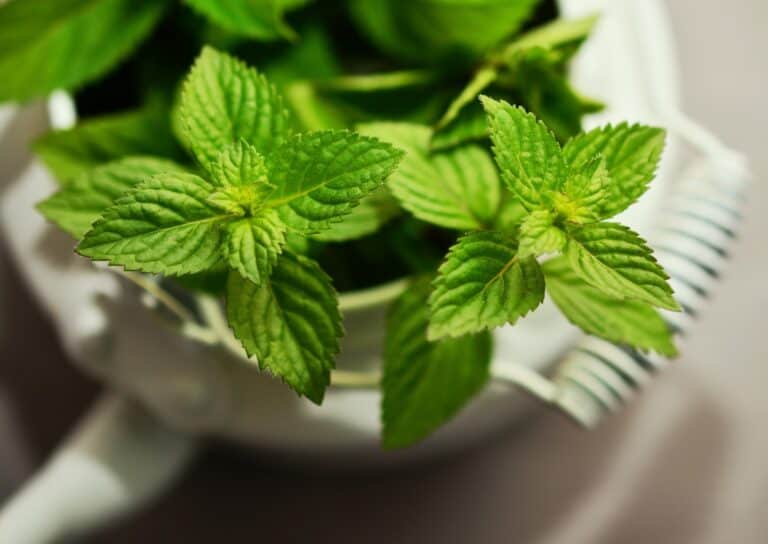
Mint grows rapidly and voraciously, meaning you’ll soon have more than you know what to do with.
Aside from making your house smell good, you can use it in ice cream and tea, a variety of desserts, and even cocktails if you are so inclined.
A sprig of fresh mint is a beautiful garnish and flavorful ingredient that you’ll soon reach for right off of the plant.
Parsley
Parsley tends to grow just as well indoors as it does out, and like mint, it will do well on or near a sunny window in soil that is kept moist, but not soaking wet.
Also, like mint and most other fresh herbs, you can pinch some off whenever you need it and relax knowing that your plan is going to keep on growing. Or alternatively you could dry it for later use.
Parsley is a classic garnish that also works wonderfully with various oils and butter, for seasoning meats, adding to vegetables or rice, and lots more.
This is an herb that a lot of people forget about in their day-to-day cooking, but that won’t be you after you get it started in your indoor garden.
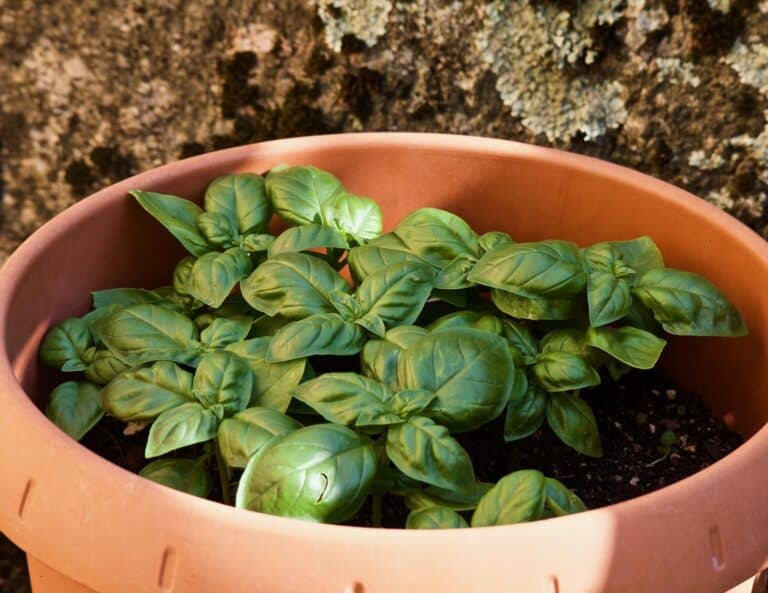
basil plant in terracotta pot
Basil
A superstar herb that is a fixture in Italian cooking and other cuisines, basil needs hardly any introduction.
It can be used in everything from salads and pizza to sandwiches and lots, lots more. A warm, sunny spot or grow light and well-drained soil is all it takes to be rolling in basil in no time.
Just make sure you cut off flowers if you want it to keep producing and maintain that delicate flavor!
Basil, like other herbs, is well suited to all sorts of containers and all kinds of methods, and this is among the easiest plants to grow indoors.
If you are only getting started on your amateur gardening journey, you could do a lot worse than planting some basil from seed or as a newly sprouted plant.
Thyme
This creeping, weedy herb needs plenty of sun and soil that is well drained and allowed to dry intermittently, but other than that it is virtually bulletproof and very easy to grow indoors.
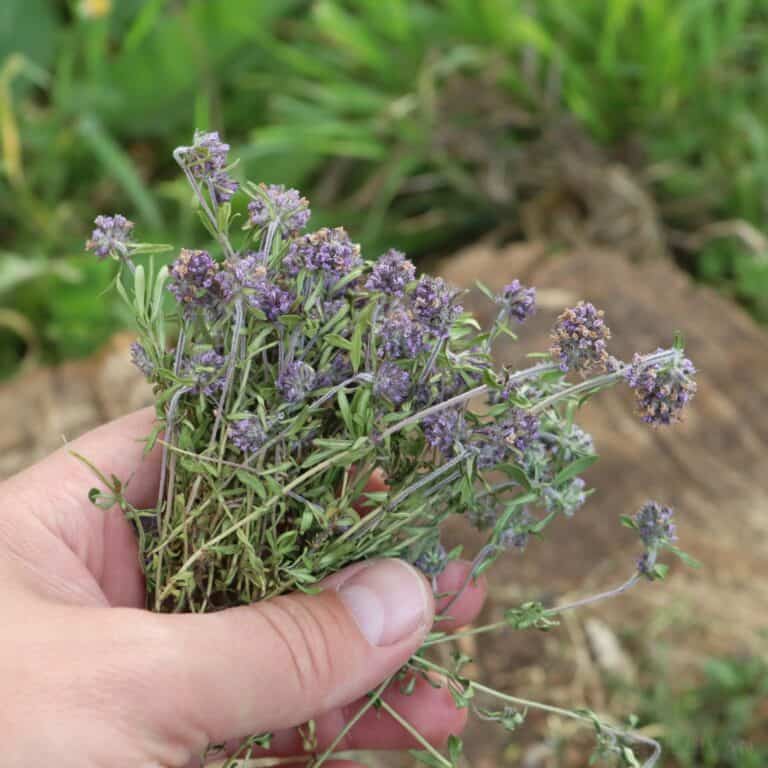
holding harvested thyme plants in hand
Thyme is an herb that usually only gets rolled out for recipes around major holidays at the end of the year, but I think that’s a shame.
It lends a wonderful bright, almost lemony flavor that works well in all kinds of dishes and particularly with mixed vegetables.
Chives
I say it about a lot of herbs, but it’s definitely true in the case of chives: this is among the very easiest of plants to grow indoors.
Give it as much sun as possible and keep moistened substrate or even a tray of water beneath the pot so they stay constantly hydrated and your chives will grow in no time.
Chives are an herb that can be used in so many different ways in so many different dishes I can hardly list them all here.
You’ll be using them all the time when you’re in the kitchen once you get used to the simple joy of grabbing some fresh ones right off the plant.
Fruit
Blueberries
If you’ve ever picked wild blueberries, you’re probably wondering just how in the hell you’re supposed to grow a bush like that indoors.
Believe it or not, it is actually entirely possible and indeed relatively easy to get delicious blueberries even when keeping your blueberry bush tiny, like the size of a houseplant.

blueberries
Blueberries don’t need tons of sun, anywhere from 6 hours a day to 9 hours a day on the far side, so it is ideally suited for a reliably sunny spot in your home or growing under a grow lamp.
Keep in mind that various blueberry bush species are better suited to different environments with differing levels of humidity and temperature, so with a little homework you can find one that is perfect for your setup.
Strawberries
Strawberries are another surprise fruit that grows wonderfully indoors. You can cram a bunch of them into one relatively small container and they don’t need a ton of light.
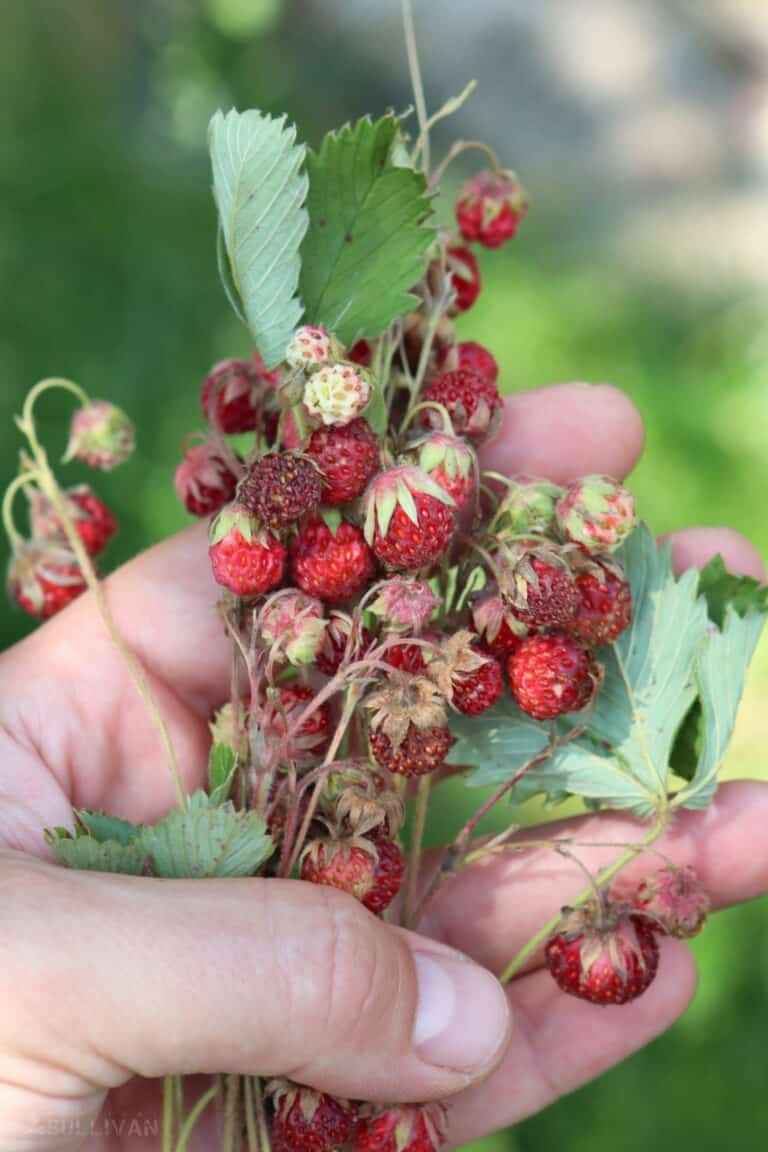
harvested wild strawberries on plant
Strawberries also do best in cooler temperatures, so your average home that’s kept comfortable is probably perfect for growing strawberries.
Just make sure you keep an eye on the moisture levels: especially in dry climates or cooler months the humidity level in your home will probably plummet and this can kill your plants.
Keep an eye on them, water as appropriate and you’ll have plenty of strawberries in no time.
Bananas
Bananas can be grown successfully indoors, and it isn’t even that hard, so long as you choose a small variety that does not need to grow into a full-size tree to produce fruit.
The trick with bananas is that some plants will only thrive if they get a lot of sunlight every day, with some species and even individual plants needing upwards of 12 hours of light.
That will almost certainly necessitate the use of grow lamps unless you have an attached sunroom, but some species and some plants might only need between 6 and 8 hours to thrive.
Like strawberries, the temperature of your home is probably perfect but do keep an eye on the moisture and humidity level and don’t let them dry out.
They will likely need watering every day or every other day in the average home in a typical climate.
Lemons/Limes
Usually thought of as tropical fruits, lemons and limes are nonetheless easy to grow indoors with the right setup.
They don’t even need high temperatures and constant sunshine! Dwarf varieties abound for both lemon and lime trees, and there are hybrids and cultivars that work wonderfully in a variety of climates.
Now, despite the fact they don’t need full-time sun, the right kind of light is important for success, so unless you have plenty of sun in a specific spot in your house that you are willing to put the tree in, definitely invest in at least one good grow light.
Don’t Forget to Save Seeds
Since you are going through all the trouble of gardening, you might as well save some seeds from your hard-won produce.
That way you can skip the whole seed-buying process for next season and just plant your own.
This is especially true for rare or heirloom varieties of vegetables, fruits, and herbs since they are often much more expensive to buy than the common varieties.
Plus there’s something quite satisfying about saving your own seeds and reaping the generational rewards!
Saving seeds from your plants is simple: The best way to do this is to let the fruits or vegetables that you are harvesting fully ripen on the plant.
After they have fully ripened, carefully remove them from the plant, gently remove any flesh or other debris from them, and place them in a dry, cool, open container to dry.
Let the seeds dry out completely before storing them in an airtight container in a cool, dark place.
When planting time arrives, you can use your saved seeds to sow new plants and watch your garden flourish anew.
Now, some types of seeds cannot be saved for replanting due to their specific characteristics.
Certain hybrid varieties of fruits and veggies, for example, are typically not able to be saved because the plant genetics are so highly modified that the resulting offspring is not viable.
Indoor Gardening Keeps You in Fresh Veggies All Year Long
Indoor gardening is becoming increasingly popular as the benefits are better understood.
Not only does an indoor garden provide you with more control over your growing process, but it also allows you to grow some produce year-round in the comfort of your own home, and in all cases is an excellent hedge against loss or disaster.
Once you start reaping the rewards of fresh herbs and veggies grown in your own home, you’ll be glad you made the switch.
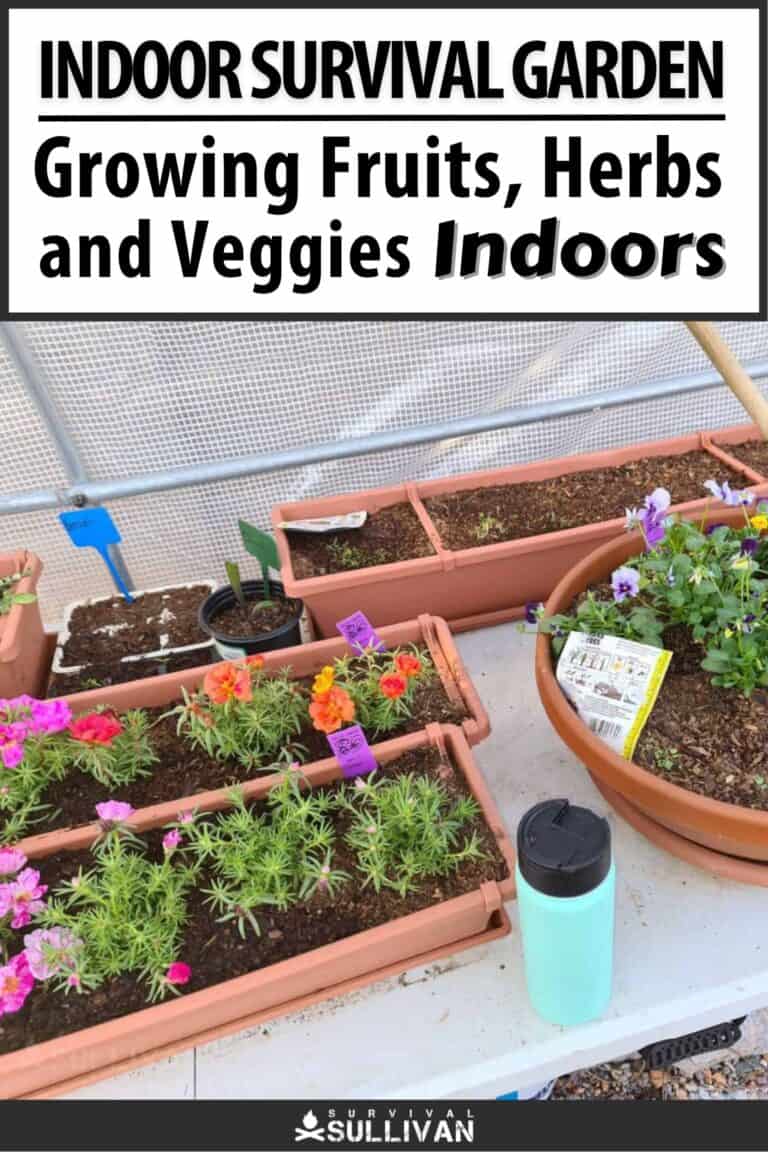
The post Indoor Survival Garden: Growing Fruits, Veggies and Herbs Indoors appeared first on Survival Sullivan.
By: Tom Marlowe
Title: Indoor Survival Garden: Growing Fruits, Veggies and Herbs Indoors
Sourced From: www.survivalsullivan.com/survival-indoor-garden/
Published Date: Thu, 09 Feb 2023 16:00:00 +0000
-------------------------------------------------------------------------
Did you miss our previous article...
https://outdoorsnewswire.com/survivalist/what-does-a-soup-sandwich-mean-in-the-military
 CampingSurvivalistHuntingFishingExploringHikingPrivacy PolicyTerms And Conditions
CampingSurvivalistHuntingFishingExploringHikingPrivacy PolicyTerms And Conditions
